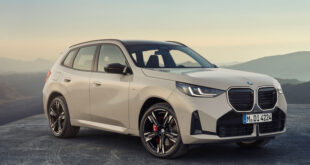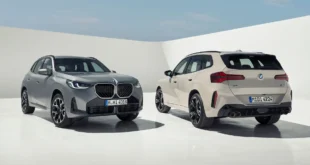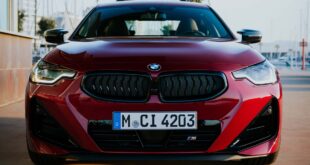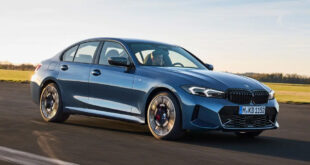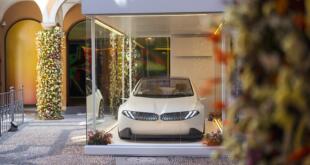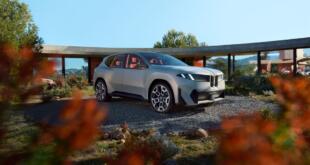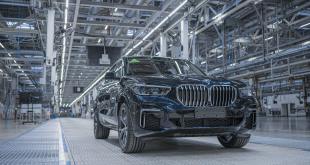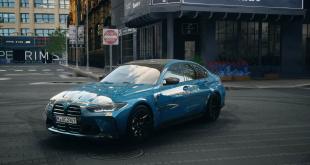For 20 years the BMW M3 has been the by-word for race-bred on road excellence in a compact car.
Over three generations, the legend has gone from strength to strength, beginning as a four-cylinder two-door coupe and flowering into a mighty six-cylinder naturally aspirated Coupé, Sedan and Convertible, the envy of the world.
As popular with fast road drivers as it was successful on track, the M3 legend was born of humble beginnings but has grown to a position of majesty.
Much copied, never matched in its purity of performance, function, and understated yet distinctive styling, the M3 today is as much in demand by enthusiasts as ever, as critically acclaimed as never before, and undoubtedly the benchmark for a plethora of would-be rivals.
Powered by a 252 kW, 3.2-litre high-technology, high-revving straight-six engine, now shared with the just launched Z4 M Roadster and the soon-to-arrive Z4 M Coupé, the 2006 M3 celebrates its 20th birthday in trade-mark understated style.
How the legend was born
The sentence has become a legend: “Mr. Rosche”, said the BMW Chairman sometime around the beginning of the 1980s, almost as an aside to his engine designer, “we need a sporty engine for the Three Series.” Eberhard von Kuenheim knew exactly who he was motivating to take action:
Paul Rosche was not only the engineering managing director of M GmbH, he was also the father of the turbo engine which had powered Nelson Piquet to victory in the 1983 World Championship, driving a Brabham BMW. And as far as Rosche was concerned, a sporty car had to do one thing: win. That was when the M3 was born.
Basic engine drawn from Formula 1
However, the designers of the sports engine weren’t exactly standing there empty-handed. The right ingredients for the projected engine were available, the mission was simply to put them together in the right way. The crankcase of the four-cylinder engine was available as a basis. This was being installed as a solid two-litre engine in volume production. Paul Rosche had long since found out about the potential really contained in the grey cast-iron housing.
It was this block that was to form the foundation stone for the champion engine of Formula 1
Four cylinders didn’t simply mean less weight and high torque for blue riband performance, but also offered ideal specifications for the projected sports engine. BMW had already introduced the six-cylinder era in the 3 Series.
But no matter how smooth and powerful the running of the in-line engine was, it had one major disadvantage for racing given the technology available at the time. As the engine speed increased, the length of the crankshaft meant that it started to vibrate much earlier than the short four-cylinder shaft. The designers therefore designed the crankshaft drive of the M3 as stiff as possible so that it could achieve in excess of 10,000 revolutions per minute.
By comparison, at that time the four-cylinder of the 318i delivered its maximum output at 5,500 rpm. The engineers were already aiming for a rated speed of 6,750 rpm for the road version of the M3, i.e. they left plenty of scope upwards.
Development goal: Group A racing car
However, any plans for a performance-enhancing supercharger had to be put to one side. A turbo was out of the question on homologation grounds. From the start, the fathers of the M3 were also thinking in terms of use as Group A racing cars, with at least 5,000 units having to be manufactured within the space of twelve consecutive months. This meant that the M3 also had to be capable of operating as an everyday road vehicle. It was therefore ideal that the engineers had already enjoyed many years of outstanding success with four-valve technology, most recently with the M1 that had only just been discontinued. Paul Rosche recalls: “We started work immediately. One advantage was that the big six-cylinder originally had the same cylinder gap as the four-cylinder engine. We therefore cut two combustion chambers off the four-cylinder head of the M88 and bolted a panel over the hole on the rear side.”
Potential for records: The first engine fires after just two weeks development
The engineers then increased the capacity even further to 2.3 litres and the first prototype was now ready. Paul Rosche: “Whether you believe it or not – we had created an outstanding four-cylinder engine for the 3 Series within the space of two weeks. Under the development name S14, this engine was to generate headlines in sport and in volume production over the years to come. One Sunday, I drove to von Kuenheim’s flat and gave him the car for a test drive. When he came back he said: ‘Good, I like it.’ And that’s how the M3 came into being.”
Fast and clean: Adopting a Catalyst barely slows the M3
However, the engineers weren’t only working on performance. The emissions of the M3 engine were also supposed to be geared to future requirements. That’s why the four-cylinder was from the start developed in such a way that it could easily be supplemented by a controlled catalytic converter. The function was by no means a simple task. In the mid-1980s, catalytic converters tended to reduce power and make engines less fuel-efficient.
Another factor was that unleaded petrol didn’t exactly have the reputation of being the ideal fuel for high-performance engines. The quality of the new fuel varied too much in Europe to meet this specification. In order to err on the safe side, the team headed by Paul Rosche adapted the engine and reduced the compression from 10.5 : 1 to 9.6 : 1.
On the one hand, this resulted in the engine not reacting to variations on the octane number with unpleasant knocking. On the other hand, the reduction in compression plus installation of the catalytic converter in the exhaust system only resulted in a loss of 5 of the standard 200 bhp.
Goal achieved: Full throttle at Nardo
Although the design engineers were pleased with the superior performance, they also spent some sleepless nights. The north loop of the Nürburgring was particularly hard on materials and what was blown into the manifold here by the four-cylinder wasn’t digested so easily by the exhaust system – the pipes were continually fracturing. It transpired that the cause was unplanned growth in the exhaust system. High temperatures at full load meant that the high-performance system became so hot that it expanded by up to 25 mm and became distorted within its mounting. A simple set of different washers solved the problem.
The drivers from BMW Motorsport GmbH immediately proved the point. On the high-speed test track in Nardo, Italy, they drove an M3 three times at full throttle over a distance of 50,000 km. The exhaust system withstood the test just like the rest of the car.
M3 goes fast even standing still
On the BMW exhibition stand at the Frankfurt Motor Show in autumn 1985, the M3 was presented to a more broadly based public audience for the first time. Even without a special paint finish, it was not difficult to distinguish the car from the other 3 Series vehicles. The boot lid was crowned by a wing across the width of the car.
Aprons all round indicated the refined aerodynamic work that had been carried out on the bodywork of the 3 Series. Anyone who spent long enough making comparisons discovered that the C-column was slightly wider and had a flatter taper in order not to interrupt the airflow over the edge of the roof and at the same time direct the airflow more effectively onto the rear spoiler.
Thick cheeks had sprouted over the wide wheels of the M3, the flared wheel arches came to an end in a striking edge below the edges of the wings. There was no question about it – the M3 looked fast even when it was perched on an exhibition stand.
Plastic parts save weight
Anyone who got that close was inclined to pat the new sports car on its chubby cheeks to see whether the bulging wheel housings had simply been attached, or whether they really had been pressed out of sheet metal. And they were impressed. The entire bodywork including the wings and the bonnet were made of metal. A lightweight plastic had been used for front and rear bumpers, and side sills and boot lid including spoilers in order to keep weight down. The M3 weighed in at 1,165 kilograms without payload on the scales and hence remained a sporty lightweight with only 5.8 kg for every 1 bhp.
The M3 kept its promises
In order to find out how the M3 performed in real life, test drivers and customers alike still had to be patient for at least another six months. It wasn’t until spring 1986 that the first pilot-production cars were ready and the M3 was launched to the press – appropriately on the racing track at Mugello.
The test drivers established that the aerodynamic profile of the M3 was an understatement rather than an overstatement – high-quality racing technology was housed under the beefy bodywork.
Axle kinematics, suspension and damping had changed. The braking system with ABS as standard comprised brake discs with ventilation at the front and a high-pressure pump operated by the engine. This servo pump delivered power to the steering at the same time so that both systems were able to operate independently of the negative pressure of the engine.
235 km/h top speed for 58,000 marks
The refined aerodynamic work paid off with an outstanding cW value of 0.35. The lift at the front axle was around half that of the other two-door 3 Series car. The large rear wing reduced the lift on the rear axle by some two thirds.
Bonded front and rear windscreens contributed to higher bodywork stiffness that in turn exerted a positive effect on driving performance. This was evident to the driver in the form of increased driving stability and more precise steering characteristics at very high speeds.
The standard M3 still reached a top speed of 230 km/h with catalytic converter and 235 km/h without catalytic converter. And yet it was relatively fuel efficient when running on super. Using the current Euromix formula made up of speed 80, 120 and town cycle, the M3 consumed significantly less than 9 litres for every 100 km/h driven.
The muscular M3 came at a price: 58,000 marks when it was launched in 1986. By comparison, the 325 Convertible at 43,300 marks was the next car down the 3 Series list.
Finding customers for the specified volume of 5,000 vehicles wasn’t a problem. In the summer of 1986 – long before delivery started – purchase contracts for the M3 at a premium price were being offered on the relevant advertisement pages. In actual fact, it wasn’t until 1987 that all 5,000 units of the first M3 were gathered on the BMW parking lot in Munich-Freimann for a family photo before being shipped all over the world.
300 bhp for competitive racing
An entire build programme disappeared again into garages and workshops to be given a new outfit. After all, the M3 had been designed as a racing car, and now was the time to prove that it really could “race”. A World Touring Car Championship was held for the first time in 1987. And that was exactly what the M3 had been built for.
But not quite in the guise in which it was seen on the streets. Instead of 200 bhp, the 2.3 litre engine delivered up to 300 bhp at 8,200 rpm in the racing version. This put it on a par with the BMW 635 CSi. BMW didn’t line up on the starting grid with its own team, but supported a number of famous racing outfits like Schnitzer, Linder or Zakspeed. Drivers like Markus Oestreich, Christian Danner, Roberto Ravaglia and Wilfried Vogt took the wheel, and Anette Meeuvissen and Mercedes Stermitz formed a ladies’ team.
But “the established racing community didn’t like the car at first”, noted one commentator. “The first test drives in Misano, Italy, turned into a battle with the more popular 635 CSi Coupé, a favourite especially with Schnitzer Team Manager Charly Lamm. When the new car proved far superior to the old one, Lamm drove the last lap in his coupé with a black flag in the righthand footwell as a signal that he was changing over to the M3.”
Roberto Ravaglia in an M3: First World Touring Car Champion
The first race for the 1987 World Touring Car Championship started on 22 March in Monza – and ended with a sensation. All the M3 cars were excluded from the placings. The vehicles were checked under chaotic conditions and disqualified because of sheet-metal thicknesses that were allegedly contrary to the regulations. BMW appealed but the sports tribunal decided that the appeal had been lodged too late. There was no longer any talk of infringements of the rules. All the brouhaha naturally didn’t have any effect on the result of the championship. At the end of the season, Roberto Ravaglia was standing on the podium as the first World Touring Car Champion. But that was only the pinnacle of the success list. Wilfried Vogt took the title of European Champion. Altfried Heger came in second – both driving a BMW M3.
The sportiest 3 Series car was also winning competitions off the race track. An M3 crossed the finishing line in first place in the Corsica Rally and secured a victory for BMW after a gap of 14 years in a race for the World Rally Championship.
“Sportiest saloon of the year”
The well-informed public rewarded the success story of the newcomer when readers of the magazine sport auto voted the M3 “the sportiest saloon of the year”. The high-profile 3 Series also became increasingly exciting in its civilian version. In 1987 it became the first BMW to be equipped with electronically adjustable shock absorbers. Drivers had a knob beside the handbrake lever which allowed them to choose between the adjustments sport, normal and comfort. A control lamp on the instrument panel displayed the setting that had been selected.
Evo arrives: Taking M3 to a new high
The resilience of the four-cylinder under tough operating conditions on the race tracks rewarded private customers with two very special offers in 1988. BMW created a small special series of even more powerful M3 cars with the suffix “Evo” for Evolution. Identifiable by even more opulent spoilers, this special M3 was powered by a 220 bhp engine. Naturally, there was also a version with a catalytic converter – this generated 215 bhp. The second offer was intended for a very special circle of customers: an open M3 based on the 3 Series Convertible. The 215 bhp convertible had a top speed of 239 km/h and was by far the fastest open-top four-seater to be bought in a limited series.
24 Hour Race: M3 scores a double victory at the Nürburgring
In the meantime, the BMW M3 was really getting going on the race track. The two-door car didn’t just win the German Touring Car Championship. It also took six other national titles, including France, England and Italy. In the following year, the BMW racing car was equally difficult to beat.
The M3 packing 300 bhp beat its touring-car competitors in Germany, Belgium, Holland, France, Italy, Finland, Spain, Sweden and Yugoslavia hands down. Belgian Marc Duez battled through the Monte Carlo Rally with an M3 and took eighth place as best driver in a car without four-wheel drive. The driver teams Piro/Ravaglia/Giroix and Heger/Grohs/Manthey crowned the success story with a sensational twin victory at the 24 Hour Race on the Nürburgring.
Specials: Evo 2 and 320is
The M3 had a commanding presence on the international touring car racing scene for five years. It became the most successful touring car of all times by winning the Champion’s title several times in the European Touring Car Championship, twice winning the German Touring Car Championship, and numerous victories and championship wins at international level. Depending on the competition rules, the four-valve engine had to be adapted to national regulations. The capacity for England was limited to 2 litres while for Germany and France it was raised to 2.5 litres with effect from 1990. This enabled the four-cylinder to deliver up to 360 bhp.
Depending on the version and the deployment profile, engine and mixture management also varied. The suction side was managed by independent throttle valves and valve control systems.
In the version with the biggest capacity, the engineers of BMW M GmbH went hard up against the limits of what was feasible, in order to make full use of the 2.5 litre limit, they not only increased the stroke of the 2.3 litre unit from 84 to 87 mm, but also increased the bores of the four cylinders from 93.4 mm each to 95.5 mm.
This reduced the width between the cylinders to just 4.5 mm.
But success proved them right. The engines withstood the stresses and strains of touring car racing even at maximum output without any problem.
A road-going version of the original M3 with the biggest capacity drove onto the roads with the additional name of Sport Evolution. Characteristic features of the car were its adjustable front apron and rear wing. The 238 bhp rocket was limited to 600 units. There was also a version of the 2.0-litre engine used in Italy for everyday use. It was designated 320is and had the stroke reduced to 72.6 mm, but at 10.8 : 1 it had a slightly increased compression.
This allowed the 2.0-litre engine to deliver 192 bhp and it was sold in Italy and Portugal so as to fall below the valid capacity limits for highly taxed luxury cars.
First generation cars notch up another victory
By the end of 1992, 17, 970 first generation M3 cars had left the small facility of BMW Motorsport GmbH, including 800 convertibles. Nobody had anticipated this overwhelming success, either on the road or on the racing circuit.
Technical data for the BMW M3
Motor
* Number of cylinders 4
* Bore x stroke 93.4 mm x 84.0 mm
* Capacity 2,302 cm³
* Output 200 bhp (147 kW) at 6,750 rpm
* Torque 240 Nm at 4,750 rpm
* Compression 10.5 : 1
Power transmission
* Gearbox 5-speed
* Gear ratio 3.72; 2.40; 1.77; 1.26; 1.00; -4.23
* Final drive ratio 3.25; limited-slip differential
* Brakes Disc brakes, front ventilated, brake servo
Chassis
* Front axle Independent suspension with suspensionstruts, transverse links and tension strut
* Rear axle inclined trailing links, coil springs and telescopic shock absorbers
* Steering Rack-and-pinion steering
Dimensions and weights
* Wheelbase 2,562 mm
* Track front/rear 1,412 mm/1,433 mm
* Length 4,345 mm
* Width 1,680 mm
* Height 1,365 mm
* Tyres 205/55 VR 15
* Weight 1,200 kg
Driving performance
* Top speed 235 km/h
* Acceleration 0-100 km/h 6.7 s
* Consumption Euromix formula 8.3 l premium
* Number of units manufactured 17,970
Technical data for the BMW M3 Sport Evolution
Motor
* Number of cylinders 4
* Bore x stroke 87 mm x 95.0 mm
* Capacity 2,467 cm³
* Output 238 bhp (175 kW) at 7,000 rpm
* Torque 240 Nm at 4,750 rpm
* Compression 10.2 : 1
Power transmission
* Gearbox 5-speed
* Gear ratio 3.72; 2.40; 1.77; 1.26; 1.00; -4.23
* Final drive ratio 3.15; limited-slip differential
* Brakes Disc brakes, ventilated at front, brake servo
Chassis
* Front axle Independent suspension with suspension
E30s… truely ROCK!!!
 BMW.SG | BMW Singapore Owners Community The Ultimate BMW Community – Established Since 2001
BMW.SG | BMW Singapore Owners Community The Ultimate BMW Community – Established Since 2001

